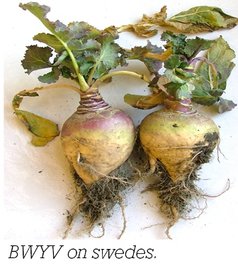Viruses
The three main brassica viruses are beet western yellows virus (BWYV), cauliflower mosaic virus (CuMV) and turnip mosaic virus (TuMV). All are common in brassica crops throughout NZ.
Identification
BWYV is characterised by colouring in the leaves, especially purples and reds, eventually turning yellow. CuMV and TuMV cause similar symptoms (test often required to differentiate). Infected plants show patterns, distortion and mottling in the leaves. Infected plants are stunted and often die if infection occurs early.

Importance
Early infection with any of these viruses can cause severe crop losses.
Spread
All are introduced into crops by aphids. The two main aphid species in brassicas, the green peach and grey cabbage aphid, are their main vectors. The main primary sources of these viruses are weeds and brassica volunteers in the vicinity of the crop.
Prevention and management
The application of aphicides can prevent the introduction of these viruses, however correct timing is difficult to achieve. Seed treatments can give seedlings up to 6 weeks protection, often long enough to protect through the critical period when aphids are flying. Seed beds should also be kept free of weeds and volunteers, especially for second year crops.

